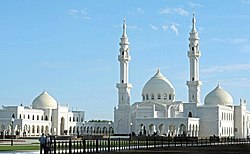Bolgar, Spassky District, Republic of Tatarstan
Town in the Republic of Tatarstan, Russia From Wikipedia, the free encyclopedia
Town in the Republic of Tatarstan, Russia From Wikipedia, the free encyclopedia
Seamless Wikipedia browsing. On steroids.
Every time you click a link to Wikipedia, Wiktionary or Wikiquote in your browser's search results, it will show the modern Wikiwand interface.
Wikiwand extension is a five stars, simple, with minimum permission required to keep your browsing private, safe and transparent.
Bolgar (Russian: Болгар; Tatar: Болгар) is a town and the administrative center of Spassky District in the Republic of Tatarstan, Russia, located on the left bank of the Volga River, 140 kilometers (87 mi) from Kazan. As of the 2010 Census, its population was 8,650.[4]
Bolgar
Болгар | |
|---|---|
| Other transcription(s) | |
| • Tatar | Болгар |
 Bolgar mosque | |
| Coordinates: 54°58′27″N 49°01′51″E | |
| Country | Russia |
| Federal subject | Tatarstan[1] |
| Administrative district | Spassky District[1] |
| Founded | 1781[2] |
| Area | |
| • Total | 8.0 km2 (3.1 sq mi) |
| Elevation | 80 m (260 ft) |
| Population | |
| • Total | 8,650 |
| • Density | 1,100/km2 (2,800/sq mi) |
| • Capital of | Spassky District[1] |
| • Municipal district | Spassky Municipal District[5] |
| • Urban settlement | Bolgar Urban Settlement[5] |
| • Capital of | Spassky Municipal District,[5] Bolgar Urban Settlement[5] |
| Time zone | UTC+3 (MSK |
| Postal code(s)[7] | 422840, 422869 |
| Dialing code(s) | +7 84347 |
| OKTMO ID | 92632101001 |
| Website | spasskiy |
It was previously known as Spassk (until 1926),[2] Spassk-Tatarsky (until 1935),[2] Kuybyshev (until 1991).[2]

The excavated monuments of Bolghar, the medieval capital of Volga Bulgaria, are within easy reach from the town. The modern town of Spassk (Спасск) was formed from the village of Spassk (Chertykovo) on the bank of Bezdna River in 1781.[2] It was renamed Spassk-Tatarsky (Спасск-Татарский) in 1926, then Kuybyshev Куйбышев), in honor of Valerian Kuybyshev, in 1935, before getting its present name in 1991.[2] It served as a district administrative center since 1930.[3]
In 1957, due to the construction of Kuybyshev Reservoir and flooding of the original Spassk, the town was moved from the place of its foundation[3] closer to historical Bolgar.
In 1991, the town changed its name to Bolgar in honor of the remains of the medieval city of Bolghar (Bolgar Historical and Archaeological Complex) located nearby.
Since 2010, on the initiative and the supervision of the first president of the Republic of Tatarstan Mintimer Shaimiev, the complex programme 'Cultural Heritage - Island-Town of Sviyazhsk and Ancient Bolgar' has been implemented in Bolgar. The programme involves the conservation of architectural and archaeological heritage of Bolgar and the development of its touristic infrastructure. The programme has the following results:
Within the framework of administrative divisions, Bolgar serves as the administrative center of Spassky District, to which it is directly subordinated.[1] As a municipal division, the town of Bolgar, together with the selo of Bolgary, is incorporated within Spassky Municipal District as Bolgar Urban Settlement.[5]
As of 1997, the town's industrial enterprises included a meat factory, a bakery, a brewery, a clothing factory, and a forestry farm.[3] The nearest railway station is Cherdakly on the Ulyanovsk–Ufa line, 71 kilometers (44 mi) south of Bolgar.[3]
Since 2010, the tourism flow to Bolgar has increased about 20 times: in 2010 Bolgar was visited by 50 000 tourists, in 2018 the annual visitation number has reached 541 000.[9] In 2016, Bolgar became the most popular touristic towns of Russia.[10]
| 2010 Census | 8,650[4] |
|---|---|
| 2002 Census | 8,655[11] |
| 1989 Census | 8,397[12] |
| 1979 Census | 8,383[13] |
As of 1989, the population was ethnically mostly Russian (83.4%), Tatar (12.9%), and Chuvash (2.1%).[3]
As of 2018, the town is on the 989 place from 1113 cities and towns of the Russian Federation in terms of the number of its inhabitants.[14]
The town is bordering the Bolgar Historical and Archaeological Complex World Heritage site. The property was inscribed to the World Heritage List in 2014 in accordance with criteria (ii) and (vi). Its architectural and archaeological heritage is considered evidence of the medieval city of Bolgar, which existed in the 7-15th centuries as a key political centre of the Volga Bulgaria and the first capital of the Golden Horde. The property also has a significant religious value as a symbolic place of the adoption of Islam by the Volga Bulgaria in 922 and serves as a pilgrimage place for Tatar Muslims.[15] The following historic monuments are located in the complex:
The Bolgar Historical and Archaeological Complex is managed by the Bolgar State Historical and Architectural Museum-Reserve, which museums are located inside of the property:[16]
There are several attractions located close to the Bolgar Historical and Archaeological Complex: